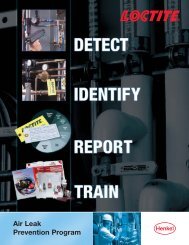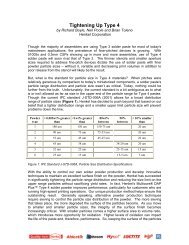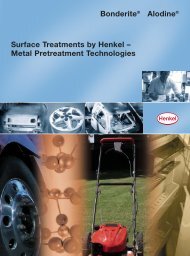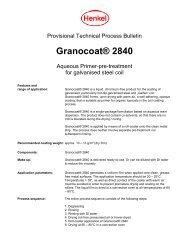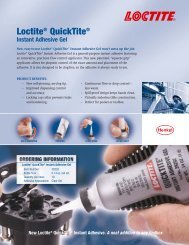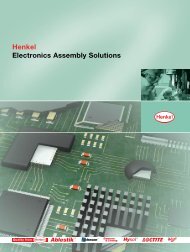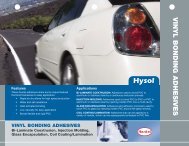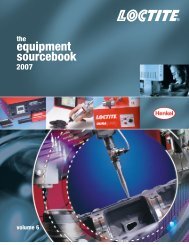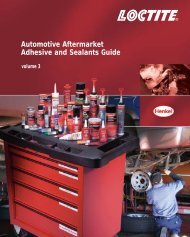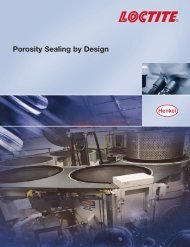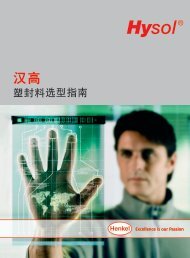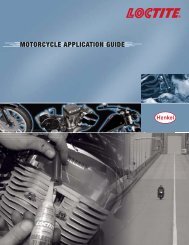SOUND ENGINEERING FROM - Loctite.ph
SOUND ENGINEERING FROM - Loctite.ph
SOUND ENGINEERING FROM - Loctite.ph
- No tags were found...
You also want an ePaper? Increase the reach of your titles
YUMPU automatically turns print PDFs into web optimized ePapers that Google loves.
Ideally, the adhesive should not be applied over apainted surface, as the bond between the paint and thesubstrate can limit overall bond strength. Activators foracrylics or any other adhesives, should be applied onlyonto the steel parts (at room temperature), so that thecarrier solvents in the activator can evaporate entirelybefore assembly. Since ceramic magnets are quiteporous, the activator applied to them can wick deepbelow the surface. So while appearing to be dry on thesurface and ready for bonding, the magnet may stillbe loaded with solvents. Trapped solvents maysignificantly slow the cure, and can weaken the ultimatebond strength.A note about the use of Ferrofluids. Ferrofluids arecoloidal suspensions of magnetic particles in an oil-likecarrier liquid, and provide improved thermal transmissionfrom the voice coil to the surrounding steel parts.Since the fluid is magnetic, it remains in the gap, completelyenveloping the voice coil, and any fluid migration(by wicking or splashing) onto nearby bondlines mustbe avoided. Ferrofluidics Corporation (603-883-9800) hasevaluated loudspeaker assembly adhesives for compatibilitywith their fluids, and has approved many <strong>Loctite</strong> ®adhesives as fully compatible.The <strong>Loctite</strong> adhesives typically used in speakerassembly do not effect, nor are effected by, incidentalcontact with Ferrofluids, once fully cured. However,uncured acrylic adhesives are known to have catastro<strong>ph</strong>iceffects upon Ferrofluids if they come into contact,causing the magnetic fluid viscosity to rise dramatically.Since <strong>Loctite</strong> ® structural acrylics are anaerobic(curing in the absence of oxygen), any excess adhesiveoutside the bondline will not cure, and will remain hazardousto Ferrofluid.Other Types of MagnetsAlong with tremendous magnetic density, Neodymium-iron-boron(NdFeB) magnets have introducedanother unwelcome feature, rapid corrosion. The qualityof the protective coatings can be a significant problemwith these magnets, depending on their source.Neodymium magnets are currently available witha variety of surface treatments such as: 1) vapordeposited aluminum, 2) electro-plated nickel, 3) electrodepositedepoxy paint, and 4) plasma depositedtitanium-nitride. Each of these coatings requires specialconsideration. Neodymium magnets should be inspectedclosely before assembly operations begin, and thosethat show oxidation should be discarded. Bonding toalready oxidized surfaces will neither create a strongbond, nor inhibit further corrosion.Neodymium, samarium-cobalt and alnico magnetsgenerally use a "pot and pole-tip" topology, rather thantop plate and pole plate. The steel parts involve thesame finishes and the adhesive recommendations arethe same as for ceramics.Assembling Speakers with <strong>Loctite</strong> ® AdhesivesRecommended products for the Pole Piece to Magnet to Top Plate Assembly:<strong>Loctite</strong> ® SpeedBonder Adhesives 324, 326 or <strong>Loctite</strong> ® Structural Adhesives 332, 392 or 3270.See detailed Product Information on SpeedBonder and Structural Adhesives on pages 18 and 19.9



